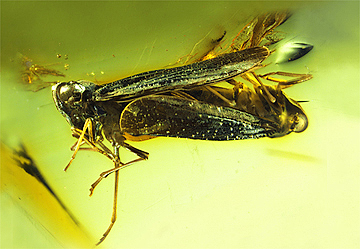Abstract
Nel et al. (2006) described Myopsocus arthuri from Dominican amber based on a single male specimen. We herein describe the female of this species, give a species diagnosis (missing in the original description) and recognize additional characters. Myopsocus arthuri represents the first and only described fossil in the family Myopsocidae.
References
Banks, N. (1941) New neuropteroid insects from the Antilles. Memorias de la Sociedad Cubana de Historia Natural, 15 (4), 385–402.
Enderlein, G. (1903) Die Copeognathen des indo-australischen Faunengebietes. Annales Musei Nationalis Hungarici, 1, 179–344.
Enderlein, G. (1907) Die Copeognathen Javas. Notes from the Leyden Museum, 29, 107–126.
Enderlein, G. (1910) Eine Dekade neuer Copeognathengattungen. Sitzungsberichte der Gesellschaft Naturforschender Freunde zu Berlin, 2, 63–77.
Grimaldi, D. & Engel, M. (2006) Fossil Liposcelididae and the lice ages (Insecta: Psocodea). Proceedings of the Royal Society of London, Series B, Biological Sciences, 273, 625–633.
https://doi.org/10.1098/rspb.2005.3337
Hagen, H. (1859) Synopsis der Neuroptera Ceylons. Pars II. Verhandlungen der K.-k. Zoologisch-Botanischen Gesellschaft in Wien, 9, 199–212.
Hagen, H. (1866) Psocinorum et Embidinorum Synopsis synonymica. Verhandlungen der K.-k. Zoologisch-Botanischen Gesellschaft in Wien, 16, 201–222.
Hakim, M., Huang, D.Y. & Azar, D. (2018) First lepidopsocid from the mid Miocene Dominican amber (Psocodea: Trogiomorpha: Lepidopsocidae). Palaeoentomology, 1 (1), 58–64.
https://doi.org/10.11646/palaeoentomology.1.1.8
Hennig, W. (1953) Kritische Bemerkungen zum phylogenetischen System der Insekten. Beiträge zur Entomologie, 3, 1–85.
https://doi.org/10.21248/contrib.entomol.3.Sonderheft.1–85
Iturralde-Vinent, M.A. (2001) Geology of the amber-bearing deposits of the Greater Antilles. Caribbean Journal of Science, 37, 141–167.
Li, F.S. (2002) Psocoptera of China. National Natural Science Foundation of China, Science Press, Beijing, xlvi + 1976 pp. [In Chinese, with English summary p. 1761–1926]
Lienhard, C. (1998) Psocoptères euro-méditerranéens. Faune de France 83, Paris, xx + 517 pp.
Lienhard, C. (2004) New Myopsocidae (Insecta: Psocoptera) from Southeast Asia, with redescription of Lophopterygella camelina Enderlein. In: Garcia Aldrete, A.N., Lienhard, C. & Mockford, E. (Eds.), Thorntoniana, a commemorative volume for Ian W. B. Thornton (1926–2002), Universidad Nacional Autónoma de México, Instituto de Biológica, Publicaciones Especiales, 20, 169–205.
McLachlan, R. (1880) Notes on the entomology of Portugal. II. Pseudo-neuroptera (in part) & Neuroptera-Planipennia. Entomologist’s Monthly Magazine, 17, 103–108.
Mockford, E. (1974) Records and descriptions of Cuban Psocoptera. Entomologica Americana, 48 (2), 103–215.
Mockford, E. (1986) A preliminary survey of Psocoptera from Tertiary amber of the Dominican Republic. Entomological Society of America Annual Conference (7–11 December, Reno, Nevada) (Abstract Volume), p. 112.
Mockford, E. (1991) New species and records of Psocoptera (Insecta) from Roraima State, Brazil. Acta Amazonica, 21, 211–317.
https://doi.org/10.1590/1809-43921991211318
Mockford, E. (1996) New species and records of Psocoptera from northern Venezuela. Tropical Zoology, Special Issue, 2, 1–98.
Mockford, E. & Garcia-Aldrete, A.N. (2014) A new genus and two new species, one extant and one fossil, in the family Troctopsocidae (Psocodea: ‘Psocoptera’: Troctomorpha: Amphientometae: Electrentomoidea). Zootaxa, 3869 (2), 159–164.
https://doi.org/10.11646/zootaxa.3869.2.5
Navás, L. (1932) Insectos de la Argentina. Revista de la Academia de Ciencias Exactas, Fisico-Quimicas y Naturales de Zaragoza, 16, 87–120.
Nel, A., Waller, A. & Poinar, G.O. (2006) The First Fossil Myopsocidae (Psocoptera) In Dominican Amber. Zootaxa, 1349, 63–68.
https://doi.org/10.11646/zootaxa.1220.1.6
New, T.R. (1980) New and little known Psocoptera from the Reserva Ducke, Amazonas. Acta Amazonica, 9 (4), 773–781.
New, T.R & Thornton, I.W.B. (1975) Psocomorpha (Psocoptera) collected on recent expeditions to South America. Journal of Entomology, Series B, 44 (1), 27–80.
https://doi.org/10.1111/j.1365-3113.1975.tb00005.x
Penney, D. (2010) Chapter 2: Dominican amber. In: Penney, D. (Ed.). Biodiversity of fossils in amber from the major world deposits. Siri Scientific Press, Manchester, pp. 22–39.
Pérez-Gelabert, D.E. (2008) Arthropods of Hispaniola (Dominican Republic and Haiti): a checklist and bibliography. Zootaxa, 1831, 1–530.
Poinar, G.O. & Poinar, R. (1999) The Amber forest. A reconstruction of a vanished world. Princeton University Press, Princeton, New Jersey, 239 pp.
Roesler, R. (1944) Die Gattungen der Copeognatha. Stettiner Entomologische Zeitung, 105, 117–166.
Ružičková, D., Nel, A. & Prokop, J. (2019) New dustywings (Neuroptera, Coniopterygidae) from mid-Cretaceous amber of Myanmar reveal spectacular diversity. ZooKeys, 827, 139–152.
https://doi.org/10.3897/zookeys.827.31961
Shipley, A.E. (1904) The orders of insects. Zoologischer Anzeiger, 27, 259–262.
Smithers, C.N. (1972) The classification and phylogeny of the Psocoptera. Memoirs of the Australian Museum, 14, 349 pp.
Smithers, C.N. (1978) A new genus of Myopsocidae (Psocoptera) from Queensland. Journal of the Australian Entomological Society, 17 (1), 105–107.
https://doi.org/10.1111/j.1440-6055.1978.tb01753.x
Smithers, C.N. (1990) Keys to the family and genera of Psocoptera (Arthropoda: Insecta). Technical Reports of the Australian Museum, 2, 82 pp.
Smithers, C.N. (2004) A new genus for three species of Australian Myopsocidae (Insecta: Psocoptera). In: Garcia Aldrete, A.N., Lienhard, C. & Mockford, E. (Eds.), Thorntoniana, a commemorative volume for Ian W. B. Thornton (1926–2002), Universidad Nacional Autónoma de México, Instituto de Biológica, Publicaciones Especiales, 20, 159–168.
Thornton, I.W.B. & Browning, J.A. (1992). Myopsocidae (Insecta: Psocoptera) from Java, including a discussion of the known Indonesian fauna. Revue Suisse de Zoologie, 99 (2), 343–367.
https://doi.org/10.5962/bhl.part.79834
Turner, B.D. (1975) The Psocoptera of Jamaica. Transactions of the Royal Entomological Society of London, 126 (4), 533–609.

